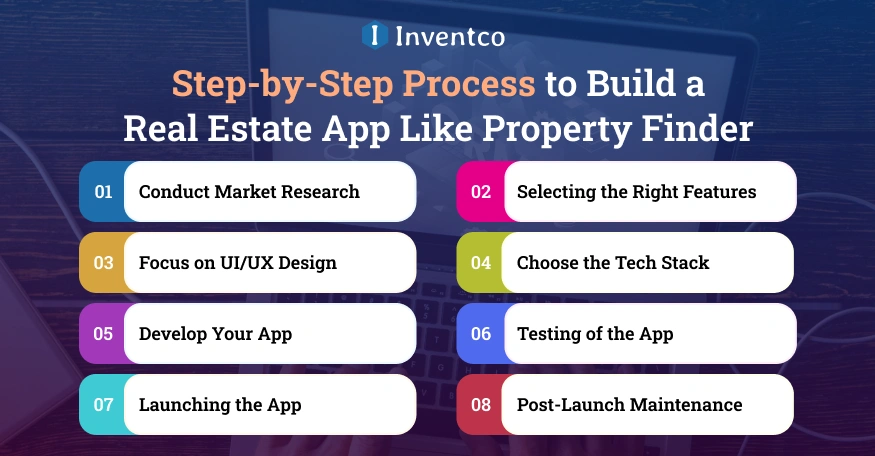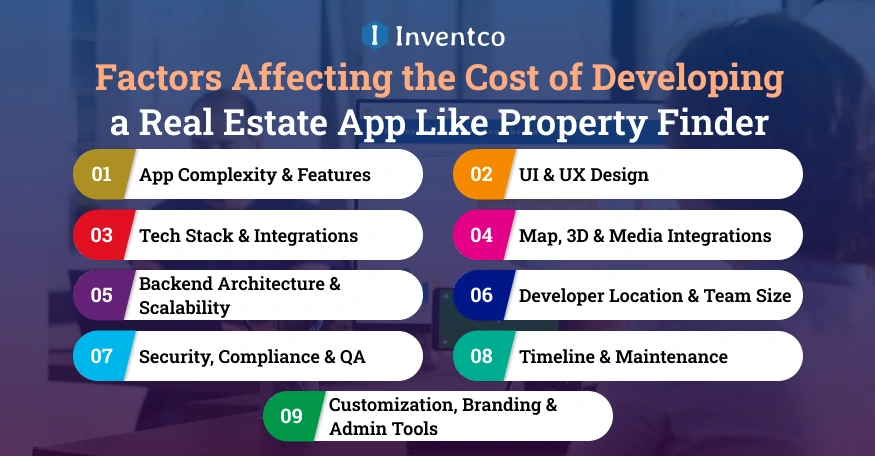Have you ever wondered how Property Finder turned into the go-to destination for millions searching for their dream home?
Property Finder is not just a sophisticated, modern real estate platform; it is also a well-designed ecosystem that makes it easy for users to compare and find the homes they want.
Today’s digital property seekers expect quality photos, verified ads, clever mapping and filtering tools to narrow their searches.
It’s no accident that Property Finder’s success has become a benchmark for entrepreneurs. Its rapid growth has inspired a wave of new projects, especially in the real estate app development space.
Property Finder’s success and its evolution into a multinational corporation with annual revenue in the millions are attributable to the clever integration of tools, user behavior analysis, and listing data.
What Is the Property Finder App & How Does It Work?
Property Finder is what you could call the Google of real estate. It is easy, reliable and fast! The app aggregates listings for real estate agents, development companies, and homeowners. It is one website that answers a home seeker’s questions.
Assigned to building a Real Estate App Like Property Finder, users can expect the same features, such as reliable property information, easy navigation, seamless interaction with real estate agents, and prompt response.
Simple as it flows, it goes: list → search → explore → connect.
This is the exact reason the success of Property Finder clone app development depends on. Users want it to be easy. Property Finder gives them ease.
How Property Finder Is Different From Other Real Estate Apps?
Property Finder is not just a listing platform. It is a data-packed, robust engine, enhanced by a focus on high-quality listings and a streamlined search process. It is a real estate app with proprietary data, a user-friendly and uncluttered interface, customizable search features, and a comprehensive real estate map.
If building an App Like Property Finder is your goal, the above strengths are your starting point. Most solutions are property-centric. Property Finder is people-centric, which is why it has grown in the MENA real estate market.
Why Invest in Developing a Real Estate App Like Property Finder?
A glance at recent trends in real estate and the accessibility of web-based information reveals the importance of a Real estate application. One cannot overstate the importance of this.
By building a Real Estate App like Property Finder, companies gain significant benefits, including extensive reach and diversified revenue streams from advertising, subscriptions, and special listings.
Dubai’s booming property market has turned digital platforms into money-making machines. When you create an App Like Property Finder, you’re not just building software, you are stepping into a high-demand, high-profit industry with long-term growth.
Essential Features to Include in a Property Finder-Like Real Estate App
In developing an App Like Property Finder, having deployed Minimal Feature sets is crucial.
These ensure a seamless search for listings across the database, credible, verified listings, a competitive offering, and empowered app users.
The app expedites home-finding for buyers and listing submissions for agents.
Here are the essentials:
1. Map-Based Property Browsing
Enabling users to display properties on a map empowers them to assess peripheral amenities and get an instantaneous feel of the neighbourhood, similar to Property Finder.
2. High-Quality Images & Virtual Tours
In line with market trends, customers expect transparency in their property transactions. Provide extensive 360-degree video tours and walkthroughs so customers can preview a property in its entirety before deciding to book a visit.
3. Verified Listings
With fraudulent listings, no-shows, and lost customers due to your platform’s lack of credibility, you need to add verified listings badges and authenticate your listings to regain credibility.
4. Neighborhood Insights
For customers, the availability of nearby schools, hospitals, the metro route, and malls, is a crucial decision influencer, so make sure to include that information.
5. Price Calculators & Financial Tools
For real estate apps to become more useful to customers and improve engagement, integrating estimating tools, such as mortgage, EMI, and affordability calculators, is essential.
6. Saved Searches & Alerts
Enable your users to save their search parameters and notify them in real-time when properties that match their search are posted.
7. Agent Dashboards
Provide your agents with tools to upload new listings, manage inquiries, track their leads, and measure their efforts through the analytic dashboards.
8. Admin Management Controls
With the Admin control panel, they should be able to verify listings, track users’ activities, manage agents, and control revenue.
With the essential features for your platform, high-quality competing real estate apps, and smooth searching, you can ensure seamless property transactions.
How to Build a Real Estate App Like Property Finder: Step-by-Step Process
Creating an app similar to Property Finder involves understanding the methodologies behind users’ property searches and selections to find their new homes. The following steps will guide you to develop this understanding:

Step 1: Conduct Market Research
Analyze the target demographic to understand the users you are designing the app for. Users are the driving force behind the app, ensuring the functionality meets their needs. Study the competition to understand what you are up against.
Research regional property trends to ensure the app does not operate contrary to market conditions. Study the app competitors (Property Finder, Zillow, Bayut) to gain insight into industry gaps and opportunities for your app.
Differentiating your app depends on understanding user behaviour, market needs, and demand.
Step 2: Selecting the Right Features
Improve the app user interface and engagement with features such as search filters, map browsing, on-web virtual tours, activity alerts, an agent dashboard, and more.
Developing an app with features that solve key user problems and integrate desirable functionality will eliminate pain points for users.
Step 3: Focus on UI/UX Design
The app will contain a high-quality user interface. Navigation will be effortless (if well-designed) and convey a clean, modern aesthetic.
Engrenew, on the other hand, will be more demanding in engaging users. A high-quality UI/UX will instill trust, which will translate into user retention. Users will browse properties without complication and do so with ease.
Step 4: Choose the Tech Stack
Your app will need a complex tech stack that’s both scalable and secure, juggling big user traffic, lightning-quick searches, and live updates.
Finding the right combination of frontend, backend, database, and APIs will allow your app to operate seamlessly, load instantly, and sustain the critical features a premium real estate platform requires.
Step 5: Develop Your App
Start the app development process by building the core modules, such as property listings and user accounts. Your app will need filters, map features, chat functionality, and dashboards.
Make sure the integration with the backend is smooth and that your code is written to high standards at every step. Development is where the app’s image as a high-performing real estate app is altered.
Step 6: Testing of the App
Widely distribute the builds of your app to people who will be performing their own testing. If they encounter any bugs or the app performs poorly, let them know.
Make sure the app supports logins, searches, and filters. Users will ultimately be the judge of the app, and their first experience with it must be the best.
Step 7: Launching the App
Your app is defined by how well it performs the features it was made to do. Make sure it performs to the best of its ability before releasing it in the app stores.
Your app will need visibility to accumulate traffic, so spend some time optimizing its appearance in app store search results.
Make sure SEO, advertising, and social media are in place and working to promote your app. This competitive real estate market requires a targeted launch strategy to be successful.
Step 8: Post-Launch Maintenance
After software deployment, focus on application updates, bug resolution, patching security vulnerabilities, and releasing new-feature updates. Use user feedback and improvement analytics to improve application performance.
Continuous application maintenance ensures that the software remains relevant, provides users with the features they need, and aligns with evolving real estate trends and expectations.
Effectively following these steps to create a real estate application, similar to Property Finder, equips your end application with the means to stand out in the growing market for real estate mobile applications.
Cost to Build an App Like Property Finder
The big question, of course, is how much it costs to build an app like Property Finder?
The cost of a real estate app depends on features, platform choice (iOS/Android), UI/UX complexity, and the development region.
An MVP is always the best choice and also a cheaper option in comparitsion to a feature-rich real estate app having the marketplace with maps, dashboards, AI-powered recommendations, and advanced integrations costs significantly more.
Most businesses asking the Cost to build a real estate app or the overall Cost to develop an App like Property Finder get one clear truth: pricing varies widely.
A simple version starts approximately at $10,000, while a highly advanced, feature-rich platform can go well over $120,000.
Factors Affecting the Cost of Developing a Real Estate App Like Property Finder
So you’re thinking about building the next big real estate platform like Property Finder? Love that for you.
But before you dive in, let’s be real: a bunch of choices shape the Real Estate App Development Cost.
Every feature, design decision, and technical choice nudges the final price tag up or down. Let’s break it down, step-by-step.

1. App Complexity & Features
The more complex the app, the more expensive it will be. For example, basic searching and listing the cost is going to be cheaper. However, things like AI recommendations, 3D tours, advanced filters, user chat, and CRM tools overall increase the price.
2. UI & UX Design
A smoother, more seamless, and more engaged interface will always positively influence engagement.
3. Tech Stack & Integrations
The type of technology and integrations will also make a difference. For example, the tech used is scalable and integrates with maps, payments, MLS/CRM systems, and AI services. The more that is done for the integrations, the more it will cost. Balancing cost versus performance is always a game.
4. Map, 3D & Media Integrations
If your application includes high-definition images, 360 tours, and AR/VR integrations, it will increase both development and operational costs.
5. Backend Architecture & Scalability
For small applications, basic backend functionality is sufficient. Otherwise, a scalable, high-performance backend architecture with search optimization, caching, and redundancy is required. This is particularly true for a marketplace with many active users, and increases costs.
6. Developer Location & Team Size
Costs vary based on location. A top-tier agency will charge more than an in-house team, and offshoring will cost more than an in-house team. Larger teams deliver faster, but also increase costs.
7. Security, Compliance & QA
Payment processing, fraud prevention, and data protection will require secure coding and additional testing. If you are targeting other regulated markets besides Dubai, compliance work and legal reviews will also need to be factored in.
8. Timeline & Maintenance
The faster the required timelines, the more resources will be required, directly impacting the budget. Maintenance and updates, as well as post-launch server usage costs, are also critical in determining the total cost of ownership.
9. Customization, Branding & Admin Tools
Costs and resulting complexity will increase from the additional requirements of custom dashboards, analytics, multilingual support, and white-label tools, but it is what will enable your product to be enterprise-ready.
How to Monetize a Real Estate App Like Property Finder?
Property Finder’s revenue game is strong, and yours can be too.
One of the best ways to monetize your real estate app is through agent subscriptions, listing fees, premium visibility, advertisement commissions, and commission-based models. Paid promotions and featured properties are very strong revenue generators.
Including various monetization models offers the best chance of capturing value when creating a Property Search App with features such as Property Finder.
Inventco: Your Trusted Partner for Real Estate App Development
Inventco specializes in building high-performing real estate platforms that users trust and businesses profit from. As a leading mobile app development company, we deliver everything from real estate app development to fully custom marketplaces and modern digital property platforms with absolute precision.
Our team blends creativity, performance, and deep market expertise to build apps that scale effortlessly. With proven experience in clone app solutions and enterprise-grade architecture, Inventco turns your vision into a powerful, beautifully crafted real estate application that stands strong in any market.

Wrapping Up
Investing in a real estate app like Property Finder is one of the best digital investments today. With the right partner, scalable software and a sound approach, your app can claim a place in the industry’s top tier. The market for mobile property discovery apps is growing rapidly. Start now! The future of real estate apps is mobile.
FAQs
Q1. How to build a real estate app like Property Finder?
Ans. To build a real estate app like Property Finder, follow a structured process involving market research, feature planning, UI/UX design, development, API integrations, testing, and a strong launch strategy to ensure performance and user satisfaction.
Q2. What is the cost to build a real estate app like Property Finder?
Ans. The cost to build a Property Finder-style app depends on features, design complexity, chosen platforms, and development region. Basic versions cost less, while advanced marketplaces with maps, AI, and dashboards cost significantly more.
Q3. Can I build a Property Finder clone app with custom features?
Ans. Yes, you can fully customize a Property Finder clone app. Adding unique features, branding, and advanced tools helps your platform stand out and deliver a more personalized and competitive user experience.
Q4. How long does development take?
Ans. Development typically takes 4–10 months depending on app complexity, number of features, team size, and integrations. Larger marketplaces with dashboards, maps, and automation may require additional time for testing and optimization.
Q5. Is Dubai a good market for launching this app?
Ans. Absolutely. Dubai is one of the fastest-growing markets for real estate technology, and Real Estate App Development in Dubai offers strong demand, high user adoption, and excellent growth potential for digital property platforms.

